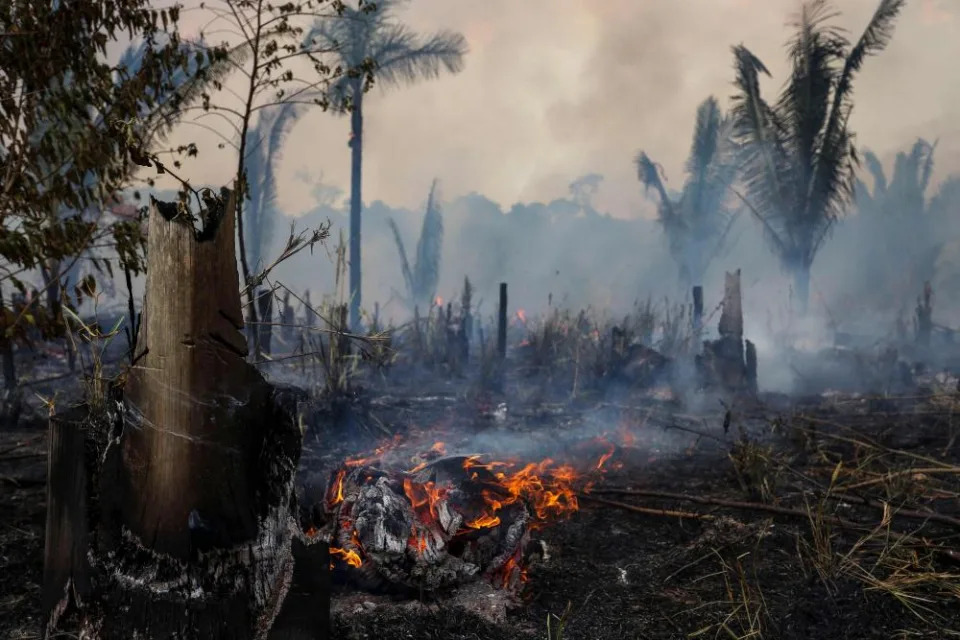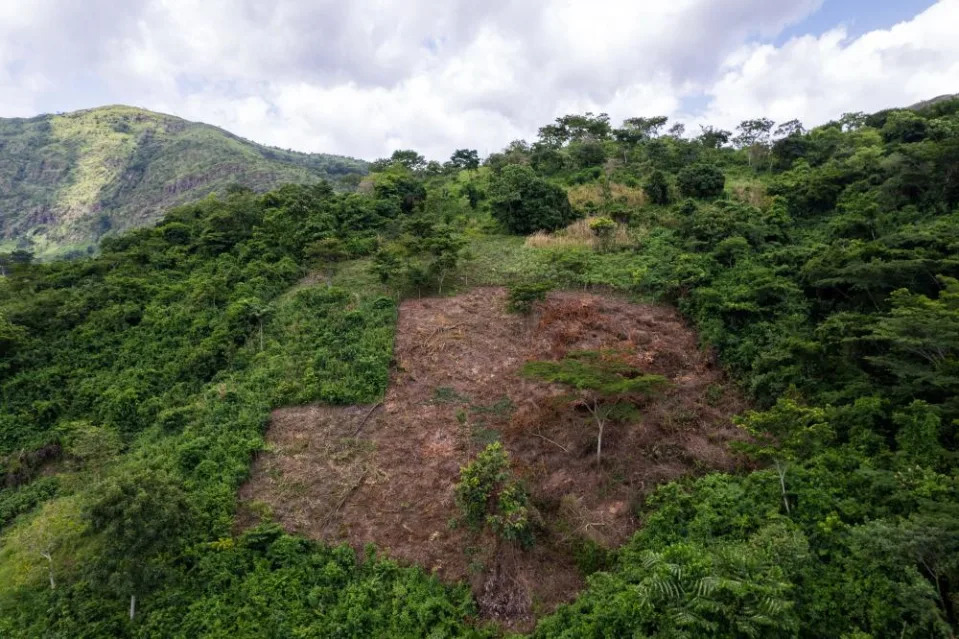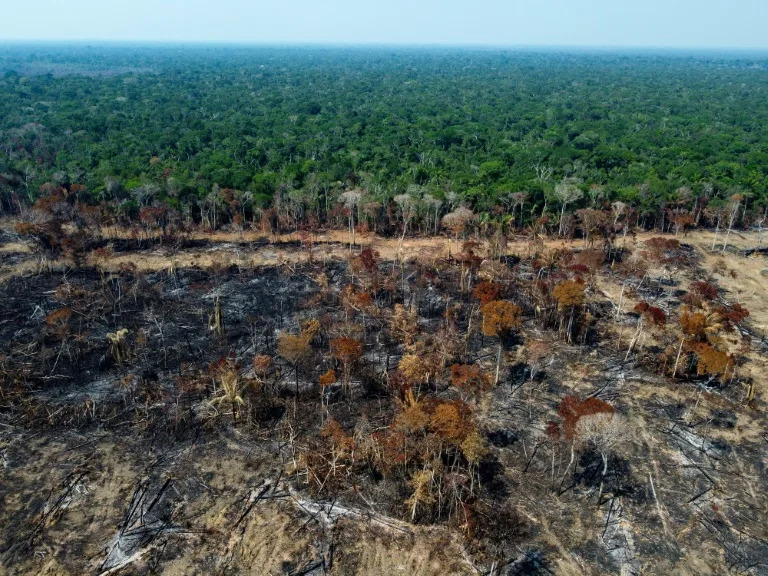Patrick Greenfield
Tue, 27 June 2023

Photograph: Michael Dantas/AFP/Getty Images
An area the size of Switzerland was cleared from Earth’s most pristine rainforests in 2022, despite promises by world leaders to halt their destruction, new figures show.
From the Bolivian Amazon to Ghana, the equivalent of 11 football pitches of primary rainforest were destroyed every minute last year as the planet’s most carbon-dense and biodiverse ecosystems were cleared for cattle ranching, agriculture and mining, with Indigenous forest communities forced from their land by extractive industries in some countries.
The tropics lost 4.1m hectares of primary rainforest in 2022, an increase of around 10% from 2021, according to figures compiled by the World Resources Institute (WRI) and the University of Maryland. The report’s authors warn that humans are destroying one of the most effective tools for mitigating global heating and halting biodiversity loss.
Land use change is the second largest source of greenhouse gas emissions behind the burning of fossil fuels and is a major driver of biodiversity loss. Limiting global heating to 1.5C above preindustrial levels is unlikely without stopping the destruction of rainforests, according to scientists.Interactive
At Cop26 in 2021, more than 100 world leaders, including Joe Biden, Xi Jinping and Jair Bolsonaro, signed up to halt and reverse deforestation by 2030 in a commitment that covered more than 90% of the world’s forests. The new data suggests that leaders are failing to deliver on their promise.
Brazil, the Democratic Republic of the Congo (DRC) and Bolivia headed the table for tropical primary forest loss in 2022. Indonesia and Malaysia managed to keep rates of loss near record low levels after significant corporate and government action in recent years. Bolivia was one of the few big forested countries that did not sign the Cop26 commitment on stopping the loss.
Ghana, a major producer of cacao for chocolate, has suffered the biggest relative increase in forest loss of any country in recent years, although the absolute figures are small.
Away from the tropics, the loss of Russia’s boreal forests slowed after a record year for destruction in 2021, but researchers said this was not an indication of a positive trend.Interactive
In response to the new figures, Inger Andersen, the UN’s environment chief, has called for a higher price for forest carbon to eliminate the short-term economic incentive to clear rainforests. Through carbon markets, countries with forests that are critical to the climate – such as Gabon, Brazil and Peru – could receive payments to keep them standing, although there are doubts about their conservation success and ability to scale to the required size. In April, a report calculated that at least $130bn (£100bn) a year was needed to protect the most at-risk areas.
“Forests are critical for our wellbeing and the wellbeing of planet Earth. Ending deforestation and halting forest cover loss are essential ingredients to fast-tracking climate action, to building resilience and to reducing loss and damage. We need to put a higher price on forest carbon, one that reflects the true value of forests, that reflects the actual cost of emissions and that is sufficient to incentivise the sellers to protect standing forests,” Andersen said.

Deforestation for agriculture, particularly cacao farming, near the Ghana-Togo border. Photograph: Muntaka Chasant/Shutterstock
“Forest protection and forest restoration is about so much more than a carbon price. It is about protecting biodiversity; protecting the livelihoods of Indigenous people and local communities, and sustaining the hydrological cycle to stabilise weather patterns and protect ourselves against landslides, soil erosion and flooding. We simply cannot afford to lose more forest cover,” she added.
Related: What is deforestation – and is stopping it really possible?
The 2022 figures cover the final year of Jair Bolsonaro’s presidency in Brazil, during which huge areas of the Amazon were cleared. Luiz Inácio Lula da Silva, his successor, has promised to end deforestation and is holding a pan-Amazon summit later this year where the issue will be discussed.
Brazil, Indonesia and the DRC, which are home to around half of the world’s remaining rainforests, are increasingly working together at UN environmental talks to demand money for protecting forests in a coalition called the “Opec of rainforests”.
The figures describe tree-cover loss, which is not necessarily deforestation. Deforestation is always done by humans while tree cover can be lost through wildfires and other events. The figures do not include regrowth or regeneration of a forest.
Find more age of extinction coverage here, and follow biodiversity reporters Phoebe Weston and Patrick Greenfield on Twitter for all the latest news and features
Football pitch of tropical forest lost every 5 seconds
Marlowe HOOD
Tue, 27 June 2023

Nearly a football pitch of mature tropical trees were felled or burned every five seconds in 2022 (MICHAEL DANTAS)
Earth lost an area of carbon-absorbing rainforest larger than Switzerland or the Netherlands in 2022, most of it destroyed to make way for cattle and commodity crops, an analysis of satellite data released Tuesday revealed.
That is nearly a football pitch of mature tropical trees felled or burned every five seconds, night and day, and 10 percent more than the year before, according to the World Resources Institute (WRI).
Tropical forests destroyed last year released 2.7 billion tonnes of CO2 into the atmosphere, equivalent to the fossil fuel emissions of India, the world's most populous nation, the WRI's Global Forest Watch unit reported.
Brazil accounted for 43 percent of the loss, with the Democratic Republic of Congo and Bolivia responsible for about 13 and nine percent, respectively.
The more than 41,000 square kilometres (nearly 16,000 square miles) decimated globally last year makes 2022 the fourth most devastating year for primary forests in two decades.
The accelerating loss comes a year after world leaders vowed at the Glasgow COP26 summit in 2021 to halt and reverse forest loss by 2030.
"Since the turn of the century, we have seen a haemorrhaging of some of the world's most important forest ecosystems despite years of efforts to turn that trend around," Mikaela Weisse, director of WRI's Global Forest Watch told journalists in a briefing.
"We are rapidly losing one of our most effective tools for combating climate change, protecting biodiversity, and supporting the health and livelihoods of millions of people."
Globally, vegetation and soil have consistently absorbed about 30 percent of CO2 pollution since 1960, even as those emissions increased by half.
- 90 billion tonnes -
Some 1.6 billion people, nearly half of them members of indigenous groups, rely directly on forest resources for their food and livelihoods.
Deforestation in Brazil surged during the four-year rule of far-right President Jair Bolsonaro, and increased 15 percent last year compared to 2021.
Bolsonaro's administration gutted environmental policies, turned a blind eye to illegal deforestation, and weakened protections of the rights of indigenous peoples proven to be effective stewards of healthy forests.
President Luiz Inacio Lula da Silva, sworn in at the start of this year, has vowed to end deforestation in the Brazilian Amazon by 2030 but will face many challenges in doing so, experts say.
Scientists fear that climate change and deforestation combined could trigger the accelerating transition of the Amazon basin from tropical forest to savannah, which could profoundly disrupt weather not just in South America but across the globe.
Some 90 billion tonnes of CO2 is stored in the Amazon basin's forest, twice worldwide annual emissions from all sources.
"Halting and reversing forest loss is one of the most cost-effective mitigation options available to us today," said Frances Seymour, WRI's distinguished senior fellow for forests.
High rates of primary forest loss also continued in the Democratic Republic of the Congo (DRC), which saw more than half a million hectares destroyed in 2022, the report said.
- Cocoa, gold & fires -
Unlike in Brazil, the main drivers were subsistence-agriculture and the small-scale production of charcoal made by cutting and burning timber, a reflection of the country's poverty.
More than 80 percent of the population lacks electricity.
A half-billion dollar agreement signed by the DRC in 2021 to protect its forests has been undermined by the recent auctioning of permits for oil and gas exploration.
The government has also indicated it would lift a moratorium on new logging concessions.
Bolivia, meanwhile, saw the third largest loss of primary forests (nearly 4,000 sq km) in 2022 and a 32 percent increase in the rate of deforestation compared to 2021.
"The majority of the loss occurred within protected areas, which cover the last patches of primary forest in the country," the Global Forest Watch report said.
Cocoa production, gold-mining and fires were the main drivers.
Just over five percent of global tropical forest loss last year occurred in Indonesia (2,300 sq km), which has seen deforestation levels drop more than four-fold since 2016.
Other countries rounding out the 'top ten' in tropical forest loss worldwide last year are Peru (3.9 percent), Colombia (3.1), Laos (2.3), Cameroon (1.9), Papua New Guinea (1.8) and Malaysia(1.7).
The rest of the world combined accounted for just under 15 percent of forest lost in 2022.
mh/fb
Marlowe HOOD
Tue, 27 June 2023

Nearly a football pitch of mature tropical trees were felled or burned every five seconds in 2022 (MICHAEL DANTAS)
Earth lost an area of carbon-absorbing rainforest larger than Switzerland or the Netherlands in 2022, most of it destroyed to make way for cattle and commodity crops, an analysis of satellite data released Tuesday revealed.
That is nearly a football pitch of mature tropical trees felled or burned every five seconds, night and day, and 10 percent more than the year before, according to the World Resources Institute (WRI).
Tropical forests destroyed last year released 2.7 billion tonnes of CO2 into the atmosphere, equivalent to the fossil fuel emissions of India, the world's most populous nation, the WRI's Global Forest Watch unit reported.
Brazil accounted for 43 percent of the loss, with the Democratic Republic of Congo and Bolivia responsible for about 13 and nine percent, respectively.
The more than 41,000 square kilometres (nearly 16,000 square miles) decimated globally last year makes 2022 the fourth most devastating year for primary forests in two decades.
The accelerating loss comes a year after world leaders vowed at the Glasgow COP26 summit in 2021 to halt and reverse forest loss by 2030.
"Since the turn of the century, we have seen a haemorrhaging of some of the world's most important forest ecosystems despite years of efforts to turn that trend around," Mikaela Weisse, director of WRI's Global Forest Watch told journalists in a briefing.
"We are rapidly losing one of our most effective tools for combating climate change, protecting biodiversity, and supporting the health and livelihoods of millions of people."
Globally, vegetation and soil have consistently absorbed about 30 percent of CO2 pollution since 1960, even as those emissions increased by half.
- 90 billion tonnes -
Some 1.6 billion people, nearly half of them members of indigenous groups, rely directly on forest resources for their food and livelihoods.
Deforestation in Brazil surged during the four-year rule of far-right President Jair Bolsonaro, and increased 15 percent last year compared to 2021.
Bolsonaro's administration gutted environmental policies, turned a blind eye to illegal deforestation, and weakened protections of the rights of indigenous peoples proven to be effective stewards of healthy forests.
President Luiz Inacio Lula da Silva, sworn in at the start of this year, has vowed to end deforestation in the Brazilian Amazon by 2030 but will face many challenges in doing so, experts say.
Scientists fear that climate change and deforestation combined could trigger the accelerating transition of the Amazon basin from tropical forest to savannah, which could profoundly disrupt weather not just in South America but across the globe.
Some 90 billion tonnes of CO2 is stored in the Amazon basin's forest, twice worldwide annual emissions from all sources.
"Halting and reversing forest loss is one of the most cost-effective mitigation options available to us today," said Frances Seymour, WRI's distinguished senior fellow for forests.
High rates of primary forest loss also continued in the Democratic Republic of the Congo (DRC), which saw more than half a million hectares destroyed in 2022, the report said.
- Cocoa, gold & fires -
Unlike in Brazil, the main drivers were subsistence-agriculture and the small-scale production of charcoal made by cutting and burning timber, a reflection of the country's poverty.
More than 80 percent of the population lacks electricity.
A half-billion dollar agreement signed by the DRC in 2021 to protect its forests has been undermined by the recent auctioning of permits for oil and gas exploration.
The government has also indicated it would lift a moratorium on new logging concessions.
Bolivia, meanwhile, saw the third largest loss of primary forests (nearly 4,000 sq km) in 2022 and a 32 percent increase in the rate of deforestation compared to 2021.
"The majority of the loss occurred within protected areas, which cover the last patches of primary forest in the country," the Global Forest Watch report said.
Cocoa production, gold-mining and fires were the main drivers.
Just over five percent of global tropical forest loss last year occurred in Indonesia (2,300 sq km), which has seen deforestation levels drop more than four-fold since 2016.
Other countries rounding out the 'top ten' in tropical forest loss worldwide last year are Peru (3.9 percent), Colombia (3.1), Laos (2.3), Cameroon (1.9), Papua New Guinea (1.8) and Malaysia(1.7).
The rest of the world combined accounted for just under 15 percent of forest lost in 2022.
mh/fb
No comments:
Post a Comment